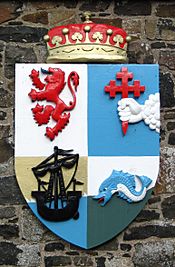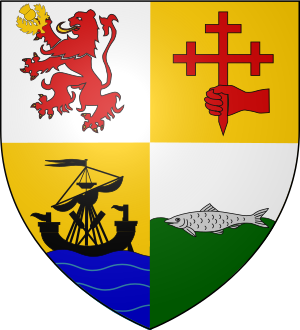MacDonnell of Antrim facts for kids
The MacDonnells of Antrim are a famous family from Ireland. They are a branch of the Clan Donald from Scotland. This family is also known as the MacDonnells of the Glens.
They became their own special branch in 1558. This happened when Sorley Boy MacDonnell took control of land in Ireland. He got this land from James MacDonald, 6th of Dunnyveg. The MacDonnells grew strong in Ireland during the 1400s and 1500s. They played a big part in Irish politics in the 1600s. Their success came from their strong family and cultural ties to other Irish noble families.
Today, most people spell the name McDonnell. But many McConnells are also from the same family. This is because McConnell is how the Gaelic name Mac Domhnaill sounds. Many leaders of the clan, including Sorley Boy MacDonnell, wrote their name as McConnell until the 1600s. Many McDonnells today are related to Sorley Boy MacDonnell.
Contents
History of the MacDonnells
Where the MacDonnells Came From
The MacDonnells of Antrim are related to John Mor MacDonald. He was a chief of the Clan MacDonald of Dunnyveg. John Mor MacDonald was the second son of Good John of Islay, Lord of the Isles. His mother was Princess Margaret Stewart, daughter of King Robert II of Scotland.
John Mor MacDonald married Margery Byset. She was the daughter of the Mac Eoin Bissett, Lord of the Glens of Antrim. The MacDonnells later claimed this land was part of her wedding gift. But the Bissetts actually owned it until the early 1500s.
After the last Mac Eoin Bissett died in battle in 1522, the MacDonnells started taking over the area. They used the old marriage to claim they had rights to the land. The MacDonnells already owned Dunnyvaig Castle on the Isle of Islay and lands in Kintyre, Scotland.
The MacDonnells of Antrim became a separate family branch in 1558. Before that, they were part of the Clan MacDonald of Dunnyveg. This change happened when Sorley Boy MacDonnell took control of the land in Ireland.
The 1400s: Early Battles
John Mor was killed in 1427 by James Campbell. John's son, Donald Balloch MacDonald, became the second chief. He led the clan to victory at the first Battle of Inverlochy (1431). They fought to support their cousin, Alexander of Islay, Earl of Ross. The MacDonalds were helped by the Clan Cameron. They fought against the King's army, led by the Earl of Mar. The King's army was supported by the Clan MacKintosh.
The third chief, Sir John Mor, his son John Cathanach, and three grandsons were captured. This happened because of a trick by the Clan MacDonald of Ardnamurchan. They were then executed in Edinburgh for treason. One of his sons, Alexander, escaped to Ireland. The person who betrayed them, MacIain of Ardnamurchan, was later killed in 1518 by those he had betrayed.
The 1500s: Sorley Boy's Rise
When James MacDonald died, his younger brother, Sorley Boy MacDonnell, took control of the Antrim Glens. Sorley Boy is famous for making the MacDonnell clan strong in Antrim. He also fought against Shane O'Neill and the English Crown. Both wanted to remove the clan from Ireland.
In 1565, under Sorley Boy MacDonnell, the MacDonnell clan fought the Battle of Glentasie against Shane O'Neill.
In April 1583, the MacDonnells, led by Sorley Boy MacDonnell, were fighting alongside the McQuillan clan. They were part of the McQuillan-O'Cahan feud. But the MacDonnells then turned against their allies. In the Battle of Aura, Edward McQuillan was killed. This led to the MacDonnells taking control of The Route and their home at Dunluce Castle.
Alaster, Sorley Boy's oldest son, was killed in 1585. His head was put on a spike in Dublin.
The 1600s: Wars and Challenges

Randal MacDonnell was a close friend of King Charles I. When the Bishops' Wars started, Randal offered to lead a sea attack against the Scottish Covenanters for the King. The King agreed, but the plans failed.
By 1645, the Scottish Covenanters had joined the English Parliament in the English Civil War. Randal MacDonnell again offered to help the King. He planned an attack from Ireland. This attack aimed to weaken the Covenanters and get back lands from Clan Campbell. The Catholic MacDonnells were fighting their Campbell enemies, who were strong Protestants.
This time, the attack happened. Alasdair MacColla (also known as Alexander MacDonnell) led soldiers from Waterford to Scotland. He gathered his Clan Donald relatives and joined with the Marquess of Montrose. Even though they were outnumbered, they won many big battles against larger enemy forces.
One of their greatest achievements was a brave winter journey. The Clan Donald forces marched through snowy mountains into the Campbell lands of Argyll. These lands were thought to be impossible to enter. They then won a huge victory against the Campbell army at the battle of Inverlochy (1645). The Campbell chief, Archibald Campbell, famously ran away on a boat while his men were being defeated. Alasdair MacColla then took over Argyll. Chief Randall MacDonnell joined him. However, the King's defeat in England stopped their success in Scotland. Many MacDonnell soldiers went back to Ireland. There, they fought against the invasion by Oliver Cromwell's forces.
MacDonnell soldiers also supported King James II in the Williamite War in Ireland.
MacDonnell Castles
The MacDonnells had several important castles:
- Dunluce Castle was the main home of the MacDonald Earl of Antrim in Ireland.
- Dunanynie Castle
- Kinbane Castle
- Red Bay Castle
- Dunnyvaig Castle was the Earl of Antrim's home in Scotland. He was also the head of the Clan MacDonald of Dunnyveg there.
See also
- Irish nobility
- Lord of the Isles
Sources
- http://www.clandonald-heritage.com
- MacDonald Family Tree


